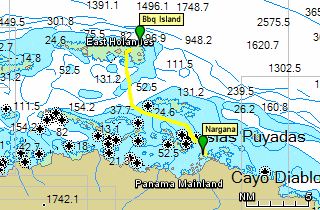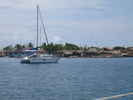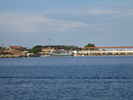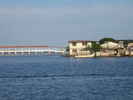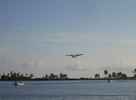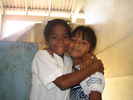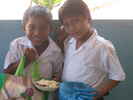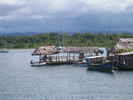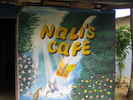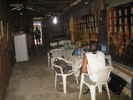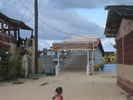12 nm to the non-traditional town of NarganaHaving had our fun at The Swimming Pool and needing an internet connection to launch the six new webpages written over the last five weeks, we weighed anchor on Sunday, Nov.16 after The Net, and headed southeast past several more chains of cays, toward the twin town islands of Nargana-Corazon. Nargana (called Yandup by the Kunas) and Corazon are two islands whose 1,000 inhabitants have chosen to abandon the traditional ways and adopt more modern trappings, such as TV's, internet, western clothes, a busy airstrip, schools, restaurants, tiendas, and homes built of concrete and tin. When we first anchored, just east of the bridge around noon, we were a little disappointed, what with the palm thatch houses on the uncrowded coconut islands a stark contrast to the dirt and grime of brickbat construction and generally crowded town-y housing. However, the charms of Nargana soon revealed themselves to us over the next 4 days. At the crack of dawn on Monday, we were greeted with not only a sunny morning, but the sights and sounds of the puddlejumper plane landing, then taking off, with its many passengers to-and-fro in water taxis. One big new advantage to being in these islands so close together to each other is that we don't have to do the dinghy drill; it's sufficient to tie the dinghy behind us as we commute from anchorage to anchorage in quarter-to-half-day passages; therefore, it is ready to transport us as soon as we are anchored. So immediately after breakfast and The Net, we grabbed our laptops and dinghied to the recommended spot, the dock for Nali's Cafe, just west of the nice, new, steel, walking bridge that connects the two islands, recently built to replace the old wooden bridge. We tied up at Nali's rickety wooden pier, walked through the pleasant palapa-roofed, sand-floor, outside seating, and through the concrete hallway to the backroom table area, which exits out to just behind the primary school that has the internet antennae. We introduced ourselves to the proprietor, waitress, and cook, who assured us we could get the wifi just fine sitting there at the table; he even plugged in an antennae booster to make sure we got a strong signal! We connected right up, ordered a couple of sodas, and commenced to catching up on e-mail and net-surfing, as well as beginning the loooong, slooow upload of the six new webpages. After an hour, back at the cafe's waterfront side, looking around and chatting with the waitress and cook, who weren't yet busy, we asked after "Nali". We were amused to discover there was no such person, but that it means "shark" in Kuna, as the papier mache shark head on the wall testified to. Meanwhile, I moved to the primary school around the corner, and was there, sitting on the stairwell landing above the computer room for better wifi reception, with two young American men on their laptops, a gaggle of cute, little schoolchildren all around. These Kuna kids are just the epitome of CUTE, always smiling and well-behaved, walking hand-and-hand, with happy, trusting eyes, genuinely curious about us visitors. They absolutely ADORE to have their photographs taken, running up to see themselves in the display, and bursting into laughter at their own images. The young men, Don and Matt, were Mormon missionaries, recently arrived from Orange County and Seattle (there are small Christian churches of five denominations on Nargana- Corazon). We asked them about the layout of the village, then went walking in search of provisions. On Tuesday at Nargana, we went in shore one more time to complete the web-page uploads, and to visit more with the other cruisers coming ashore for internet and provisioning too, as well as to enjoy the icy-cold beers and delicious lunches of sauteed lobster or chicken, mashed breadfruit and capers, and french fries at Nali's Cafe. We also chatted there with Sammy, a Kuna man who lived in Detroit, MI, in the 1950s, playing basketball for an area college; he speaks perfect English. We learned from him and others that quite a few Kunas have emigrated to the US over the years. Later, we walked about the village again, buying dozens of fresh madu (the Kuna bread) at 5 cents each. We got some at a private house and some more at a bakery complete with a modern steel oven. We continued on to the Bodega Yandup at the foot of the bridge to purchase beer, wine, and cola. Colombian traders had blankets spread out across from the Bodega, selling DVDs, CDs, toothpaste, bar soap, kids underwear, brassieres, and cartoon-character backpacks. Small Colombian tradeships come in almost every day to the commercial dock on the Corazon-side. We finished up our time in Nargana with a lazy Wednesday on the boat and a happy hour visit with Chris and Elaine from K-SERA, an interesting couple from Australia, who have farmed, published a newspaper, and served in their area's council seat, before retiring to the cruising life. The next day was Thursday the 20th, and with our visas needing renewal by the 24th, we thought we'd be peremptory and scoot back to the offices at Porvenir before the weekend. |

